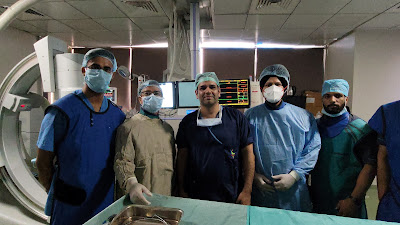Aneurysm Flow Diverter Treatment
What does flow diversion entail?
Instead of inserting a device inside the aneurysm sac, as with coiling, a flow diversion device is placed in the parent blood artery to divert blood flow away from the aneurysm.
What is the procedure for flow diversion/Pipeline?
- Slide for flow diversion
- The Pipeline stent is being inserted.
A microcatheter is steered through the aneurysm without needing to enter it during a flow-diversion/Pipeline treatment. Then, in the parent blood vessel where the aneurysm is situated, the flow-diverting device (Pipeline Embolization Device) is deployed across the neck of the aneurysm.
The blood flow to the aneurysm is reduced almost immediately, and the aneurysm closes completely between 6 weeks and 6 months after the treatment. Reasons for performing flow diversion
An unruptured brain aneurysm may be treated using a flow diversion technique. Flow diversion is one way for avoiding the most risky phase of endovascular aneurysm treatment: entering the aneurysm. By not putting a device into the aneurysm, the chance of it rupturing during surgery is considerably reduced. For wide-necked side-wall aneurysms, flow diverters are employed to provide a curative endovascular therapy option. 1–4 The majority of the high-quality data available for these devices comes from the treatment of large and enormous aneurysms. The flow of blood from the parent artery into the aneurysm is disrupted by a flow-diverter stent, which gradually slows the flow of blood into the aneurysm and, over time, prevents blood from entering the aneurysm altogether.
Doctors do not need to operate on the aneurysm during flow diversion. Doctors doing this procedure include:
To observe your blood vessels clearly, use modern imaging technologies and radioactive contrast dye.
Pass a catheter through your blood vessels until it reaches the aneurysm's location.
The flow of blood from the parent artery into the aneurysm is disrupted by a flow-diverter stent, which gradually slows the flow of blood into the aneurysm and, over time, prevents blood from entering the aneurysm altogether.
Place a stent, a small, clever device, in the parent blood vessel of the aneurysm, where the aneurysm developed, with care. This redirects blood flow away from the aneurysm, guaranteeing that it is no longer a threat to your health.
BEFORE FLOW DIVERSION
Blood flows freely into the aneurysm.
FLOW DIVERSION TECHNIQUE
After treatment with Pipeline Flex, blood flow into the aneurysm slows. Over time, blood may no longer flow into the aneurysm.
AFTER FLOW DIVERSION
What are the possible side effects of endovascular coiling?
· Consciousness loss.
· Transient ischemic attack (TIA) or stroke (TIA, a temporary stroke-like condition)
· One-half of the body is paralysed.
· Clot of blood.
· Bleeding.
· A swollen region caused by a blood collection (hematoma)
Sudden dizziness, impaired vision, and seizures are all indications of a brain aneurysm. Some people experience nausea, vomit, confusion, or drooping eyelids (further symptoms of a stroke are also possible)
Medical applications:- Flow diverters are an alternative to endosaccular coil embolization for cerebral aneurysms (although the two methods can be used together, especially in large/giant aneurysms). It is most successful in unrupted saccular aneurysms with a large neck that are difficult to coil due to the coils' tendency to fill the parent artery (referred to as prolapse). Fusiform shape or circumferential aneurysms are another scenario. Many intracranial aneurysms went untreated before flow diverters were invented.
What are the hazards and complications of installing a flow diverter?
With the advancement of technology, the complication rate is now less than 5% in expert hands. Hematoma (blood clot in the groyne), hemorrhagic or ischemic stroke (small or large) are all possible complications. However, in most circumstances, these can be prevented with good procedure planning, device selection, and post-procedure care.
Dr Sandeep Sharma is Best doctor for Acute Stroke Mechanical Thrombectomy. He is an expert in both suction retrieval and stent retrieval and uses both techniques in perfect combination.






Comments
Post a Comment